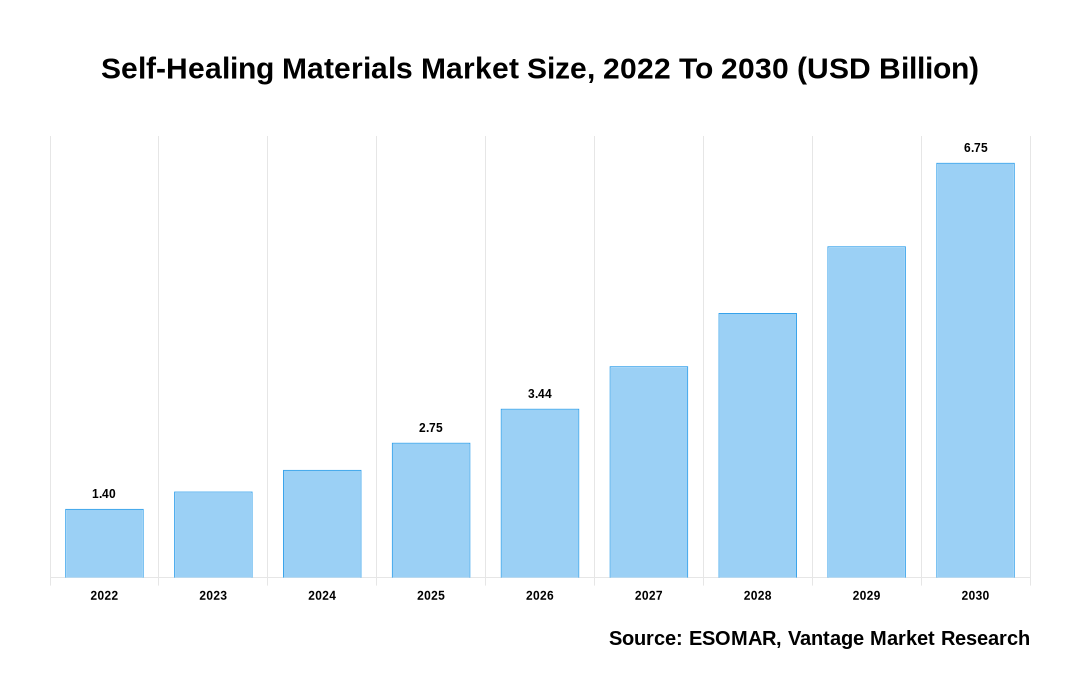Global Self-Healing Materials Market
As stated in our extensive report, the Global Self-Healing Materials Market accounted for USD 1.4 Billion in revenue in the year 2022 is projected to reach a value of USD 6.75 Billion by 2030.
The demand for self-Healing Materials has surged in recent years, particularly in the automotive and construction industries. These materials possess the ability to repair themselves automatically without any human intervention, making them ideal for high-stress applications that require long-lasting durability. Self-Healing Materials work by incorporating microcapsules or vascular networks that contain a healing agent within the material’s structure. When damage occurs, the healing agent is released, which reacts with the surrounding environment to repair the material.
This innovative technology is gaining popularity in various industries, including automotive, construction, electronics, aerospace, and healthcare, among others. The automotive industry, in particular, is one of the primary drivers of the Self-Healing Materials market. These materials are being used in various applications, such as automotive coatings, windshields, and tires, among others, to provide superior durability and long-lasting performance. The construction industry is also using Self-Healing Materials in building and infrastructure applications, such as bridges, roads, and pavements, to improve their longevity and reduce maintenance costs.
Click To Get a Free Sample On the Research Study

However, the high cost associated with developing and manufacturing Self-Healing Materials could prove to be a significant barrier to market growth. Additionally, the lack of standardized testing procedures and regulatory frameworks could also hinder market growth.
Key Factors Influencing Global Self-Healing Materials Market Growth
The growth of the global Self-Healing Materials market can be attributable to the following:
- The Self-Healing Materials market is expected to experience significant growth due to the increasing demand from end-use industries such as automotive, construction, and electronics. Self-Healing Materials are being used in these industries to reduce maintenance costs, increase the lifespan of materials, and enhance the durability of the final product.
- The development of new Self-Healing Materials with improved properties such as longer lifetimes, increased strength, and improved functionality is expected to drive the growth of the Self-Healing Materials market. Research and development in the field of material science is leading to the creation of innovative Self-Healing Materials with applications in various industries.
- Government initiatives and support for the development and adoption of sustainable and eco-friendly materials are expected to drive the growth of the Self-Healing Materials market. Various governments around the world are investing in research and development of Self-Healing Materials and providing incentives for their adoption in various industries.
- Self-Healing Materials offer the unique advantage of being lightweight and high strength, which makes them ideal for use in aerospace and defence industries. The growing demand for lightweight and high-strength composite materials in these industries is expected to be a huge driver the growth of the Self-Healing Materials market.
- The increasing awareness about the importance of sustainable materials and their role in reducing carbon emissions and promoting eco-friendliness is expected to drive the growth of the Self-Healing Materials market. Self-Healing Materials are sustainable and offer a promising solution for the development of environmentally friendly products.
Europe Region Forecast to Take Over the Market
According to our reports, Europe is predicted to dominate the Self-Healing Materials market till 2030. The region’s rapid economic development and increasing infrastructure projects are driving demand for Self-Healing Materials in construction and transportation applications. Moreover, the region is home to some of the world’s largest automotive and electronics industries, which are expected to drive the market for Self-Healing Materials in the coming years. The presence of major market players and increasing government initiatives to promote sustainable and eco-friendly products is also predicted to contribute to the growth of the Self-Healing Materials market in the Europe region.
Conclusion
The Self-Healing Materials market sales have been favorably impacted by the rising number of housing projects and a shift towards nanotechnology-driven smart construction materials.
The well-known players in the Global Self-Healing Materials Market include The Dow Chemical Company (U.S.), Covestro AG (Germany), High Impact Technology LLC (U.S.), Huntsman International LLC (U.S.), Michelin Group (France), McDermid Autotype Ltd. (UK) to name a few.
![[Market Research Reports] – Research Google News Blog | VMR.Biz](https://www.vmr.biz/wp-content/uploads/2022/12/logo-removebg-preview.png)











